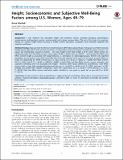Height, Socioeconomic and Subjective Well-Being Factors among U.S. Women, Ages 49–79

View/
Author
Published Version
https://doi.org/10.1371/journal.pone.0096061Metadata
Show full item recordCitation
Wyshak, Grace. 2014. “Height, Socioeconomic and Subjective Well-Being Factors among U.S. Women, Ages 49–79.” PLoS ONE 9 (6): e96061. doi: 10.1371/journal.pone.0096061Abstract
Background: A vast literature has associated height with numerous factors, including biological, psychological, socioeconomic, anthropologic, genetic, environmental, and ecologic, among others. The aim of this study is to examine, among U.S. women, height factors focusing on health, income, education, occupation, social activities, religiosity and subjective well-being. Methods/Findings: Data are from the Women's Health Initiative (WHI) Observational Study. Participants are 93,676 relatively healthy women ages 49–79; 83% of whom are White, 17% Non-White. Statistical analyses included descriptive statistics, chi-square and multivariable covariance analyses. The mean height of the total sample is 63.67 inches. White women are significantly taller than Non-White women, mean heights 63.68 vs. 63.63 inches (p = 0.0333). Among both Non-White and White women height is associated with social behavior, i.e. attendance at clubs/lodges/groups. Women who reported attendance ‘once a week or more often’ were taller than those who reported ‘none’ and ‘once to 3 times a month’. Means in inches are respectively for: White women–63.73 vs. 63.67 and 63.73 vs. 63.67, p = 0.0027. p = 0.0298; Non-White women: 63.77 vs. 63.61 and 63.77 vs. 63.60, p = 0.0050, P = 0.0094. In both White and Non-White women, income, education and subjective well-being were not associated with height. However, other factors differed by race/ethnicity. Taller White women hold or have held managerial/professional jobs–yes vs. no–63.70 vs. 63.66 inches; P = 0.036; and given ‘a little’ strength and comfort from religion’ compared to ‘none’ and ‘a great deal’, 63.73 vs. 63.66 P = 0.0418 and 63.73 vs. 63.67, P = 0.0130. Taller Non-White women had better health—excellent or very good vs. good, fair or poor–63.70 vs. 63.59, P = 0.0116. Conclusions: Further research in diverse populations is suggested by the new findings: being taller is associated with social activities –frequent attendance clubs/lodges/groups”, and with ‘a little’ vs. ‘none’ or ‘great deal’ of strength and comfort from religion.Terms of Use
This article is made available under the terms and conditions applicable to Other Posted Material, as set forth at http://nrs.harvard.edu/urn-3:HUL.InstRepos:dash.current.terms-of-use#LAACitable link to this page
http://nrs.harvard.edu/urn-3:HUL.InstRepos:27031446
Collections
- FAS Scholarly Articles [18292]
Contact administrator regarding this item (to report mistakes or request changes)


